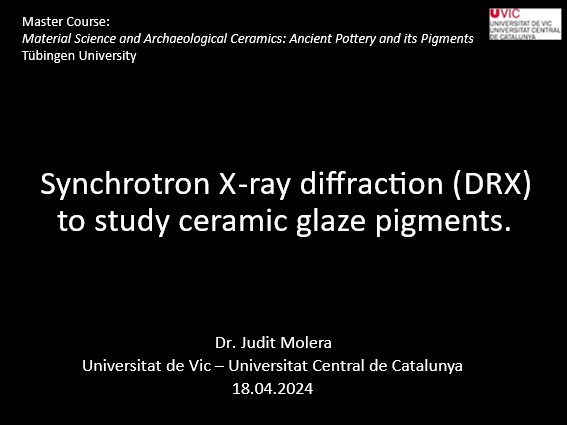Judit Molera delivered a conference on “Synchrotron X-ray Diffraction (DRX) to Study Ceramic Glaze Pigments” as part of the Material Science and Archaeological Ceramics Master Course of Tübingen University, organized by Silvia Amicone.
Synchrotron X-ray diffraction is a powerful tool for analyzing ceramic glaze pigments because it offers high resolution, precise identification of crystal phases, quantitative analysis and sensitivity to changes in the material’s structure. These capabilities make it an invaluable technique for studying the composition, properties, and manufacturing processes of ceramic glazes in archaeological, historical, and scientific contexts.
This Master was attended by students from various parts of the globe including Canada, the United States, Europe, China. The course provided a comprehensive introduction to pigment study and decoration techniques in archaeological ceramics.
This course offers a broad introduction to the technological study of pigments and decoration techniques in archaeological ceramics through a material science approach. It provides training in the principles of optical microscopy, X-ray diffraction, Raman spectroscopy, X-ray fluorescence and scanning electron microscopy, as needed for the interpretation of pottery decorations.
Time Schedule of the Master Course: Material Science and Archaeological Ceramics: Ancient Pottery and its Pigments
starting on 15.04.2024 at 13ct in the Übungsraum Lothar Meyer Bau Wilhelmstrasse 56
Monday April 15th, 2024
13.00 – 13.30 Welcome
13.30 – 14.30 Introduction to the pottery production process (Silvia Amicone)
14.30 – 15.00 Break
15.00 – 16.00 Optical microscopy, theory (Silvia Amicone)
16.00 – 16.30 Optical microscopy, practical demonstration (Sinem Hacıosmanoglu)
16.30 – 17.00 Summary and discussion
Tuesday April 16th, 2024
9.00 – 9.30 Introduction
9.30 – 10.45 Iron black and manganese black (Silvia Amicone)
10.45 – 11.00 Break
11.00 – 12.30 X-ray diffraction, theory (Christoph Berthold)
12.30 – 13.30 Break
13.30 – 14.00 Micro X-ray diffraction, practical demonstration (Eirini Koutouvaki)
14.00 – 14.30 Summary and discussion
14.30 – 15.00 Break
15.00 – 16.30 (online) Richard Jones (University of Glasgow) Late Bronze Age Aegean-type pottery in Italy: questions and issues to be tackled by archaeometric and archaeological methods.
Wednesday April 17th, 2024
9.00 – 9.30 Introduction
9.30 – 10.45 Carbon-based pigments (Silvia Amicone)
10.45 – 11.00 Break
11.00 – 12.30 Raman spectroscopy, theory (Baptiste Solard)
12.30 – 13.30 Break
13.30 – 14.00 Raman spectroscopy, practical demonstration (Sinem Hacıosmanoglu)
14.00 – 14.30 Summary and discussion
15.00 – 16.30 (online) Alfonso Zoleo (University of Padova) IR techniques applied to the characterization of pigments and dyes: an overview.
Thursday April 18th, 2024
9.00 – 9.30 Introduction
9.30 – 10.45 Colouring Agents for Glass and Glazes (Susanne Greiff)
10.45 – 11.00 Break
11.00 – 12.30 X-ray fluorescence analysis and scanning electron microscopy, theory (Lars Heinze)
12.30 – 13.30 Break
13.30 – 14.00 X-ray fluorescence analysis and scanning electron microscopy, practical demonstration (Baptiste Solard and Lars Heinze)
14.00 – 14.30 Break
14.30 – 15.00 Summary and discussion
15.00 – 16.30 (online) Judit Molera (University of UVic-UCC, Barcelona) Synchrotron X-ray diffraction (DRX) to study ceramic glaze pigments.
Friday April 19th, 2024
9.00 – 9.30 Introduction
9.30 – 10.30 Iron oxidation technique (Silvia Amicone)
10.30 – 10.45 Break
10.45 – 12.15 Cold pottery pigments (Silvia Amicone)
12.15 – 13.15 Final remarks



Leave a Reply